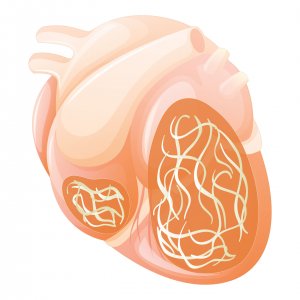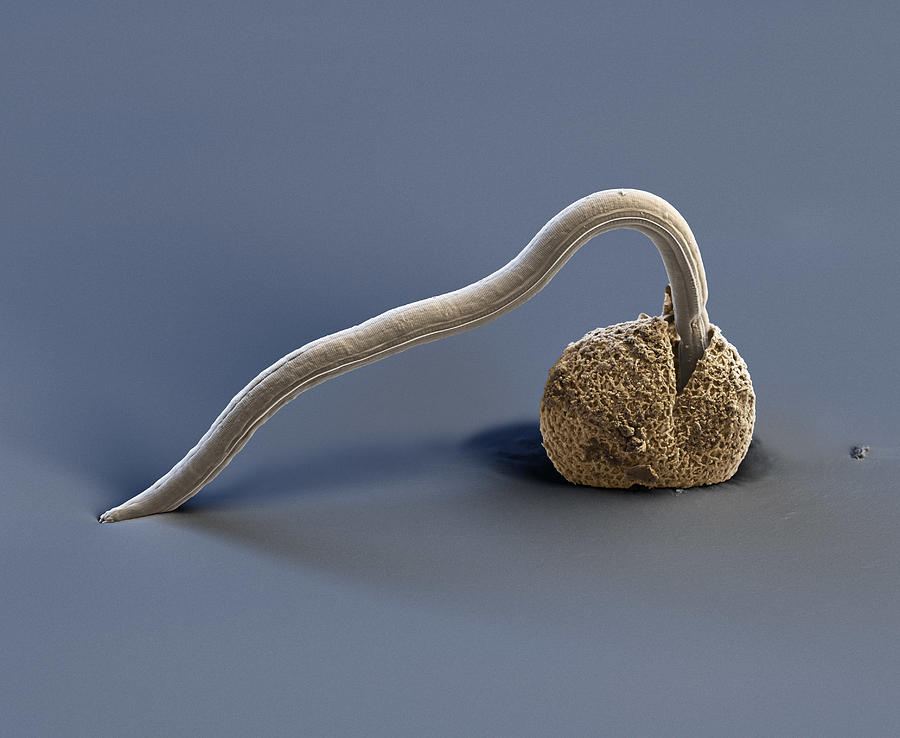Last month I touched on the importance of parasite prevention when it comes to ticks. This month I would like to bring focus the some of the worms in your pets’ life. Zoonoses describes an infectious disease that has been transmitted from animals to humans and some of the worms I discuss below have this ability. Another important reason to keep on top of worms is to decrease the population number in your community which decreases the risk to ourselves and our pets.
Heartworm (Dirofiliaria immitus)
This parasite is spread by mosquitos, not in the feces as most other worms are. They take a blood meal from an animal that has circulating immature worms in their bloodstream and transfers them to a new host animal, possibly your dog. It takes 6 months for the worms to mature and be able to cause disease in the host. This is why when testing for possible heartworm exposure, your veterinarian may recommend a series of 2 heartworm tests depending on how long your animal may have been exposed. They can grow to 30cm in length and live in the heart, lungs and associated blood vessels of your pet. Often clinical signs are not present or may go unnoticed until the disease is in its late stages. Signs may include coughing, lethargy and exercise intolerance. As things progress some may experience difficulty breathing or an enlarged abdomen which is linked to the underlying heart disease being caused. The recommended treatment for heartworm is minimum 3 months long, can be costly and is not without risks so staying up to date with regular prevention is key. A special note to add, this is the only worm where prevention can be given in an injectable form as well as oral.


Hookworm (Ancylostoma and unicaria)
There are 5 hookworm species identified in cats and dogs in Australia. An Australia wide study showed 6.7% of dogs and 1.4% of cats had hookworm and 25% domestic dogs in QLD had it. Your pet becomes infested through ingesting larvae in a contaminated environment, ingesting an intermediate host, or larval migration through skin. One species can also be passed trans mammary from mum to pup. They live in the small intestine; eggs are excreted in feces and develop into infective larvae. As they feed on your pet’s blood signs in puppies include haemorrhagic diarrhoea, pale mucous membranes, failing to thrive and death. In adults it more commonly causes weight loss, gut issues and anaemia due to age and exposure related immunity. Humans are affected by larvae penetrating through skin usually when walking or laying on contaminated soils and sand, or through ingestion on contaminated surfaces and food. This can cause a condition called cutaneous larva migrans (CLM) which causes an itchy rash.
Roundworms (Toxicara spp)
Three species of roundworms are known to infest dogs and cats in Australia. They are transmitted through ingesting raw meat or hunting other animals and birds, ingesting eggs from the environment, trans mammary and transplacental. In young pups it affects them with a pot belly, sore abdomen, anorexia, diarrhoea and vomiting but can lead to more serious complications. Humans acquire these worms through ingestion of eggs from contaminated food, water or soil, or undercooked meat. Female roundworms can lay approx. 200, 000 eggs per day. Eggs are highly resistant to chemical disinfectants and can survive for years in the environment. It is estimated that 7% of Australians are seropositive for Toxocara antibodies meaning they have either a current or prior infection. Most people are asymptomatic but possible syndromes include visceral, ocular and neural larva migrans.
Tapeworms
The two more important species of tapeworm in Australia are the flea tapeworm (Dipylidium caninum) and the hydatid tapeworm (Echinococcus granulosus). Neither form does any harm to your pet but the second can cause disease in people. Studies reveal that the prevalence is 1.9% in rural dogs on the mainland, 29% of dogs from farms in south-east NSW and up to 100% in wild dogs in NSW. Often no symptoms are observed but you may notice your pet has an itchy bottom or you may even be lucky enough to see some in their feces or coming from their bottom- they look like small grains of rice. The adult flea tapeworm lives in the small intestine of dogs and cats who pass eggs in their feces. Fleas are an intermediate host; they eat the eggs in the environment and your pet becomes infected after ingesting a flea containing the tapeworm. Adequate flea control will minimise the risk of infection significantly.
The adult hydatid tapeworm also lives in the small intestine and is passed in feces however the intermediate hosts for this species include grazing animals such as kangaroos or sheep. These animals develop cysts in their organs and dogs become infected by eating this raw offal. For this reason, dogs red raw diets, farm dogs and those that scavenge carcasses are at higher risk. Humans becomes infected by close contact with an infected dog or an indirect transfer in contaminated food, water and soil. Cystic echinococcosis causes hydatid cysts to grow in internal organs which can cause a number of secondary complications especially when they leak or rupture.
Regular worming treatment is effective to keep the risk of these worms to a minimum. There are however some other things you can be doing to keep the zoonotic risk in particular low. This involves general hygiene especially after touching your pet, cleaning up feces as soon as possible, wearing protective clothing (shoes) outdoors, covering your children’s sandpit when not in use and washing food products.
While pets bring great joy to our lives they are not without risk. Parasite control is part of responsible pet ownership to not only protect your pet, but your family and your local community also.
Statistics taken from the ‘Companion Animal Zoonoses Guidelines’, Australian Companion Animal Zoonoses Advisory Panel.







